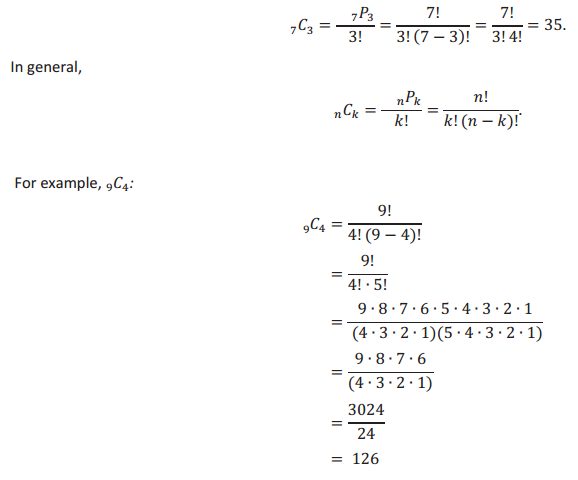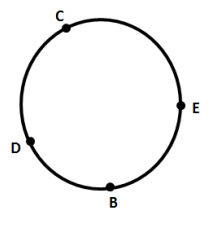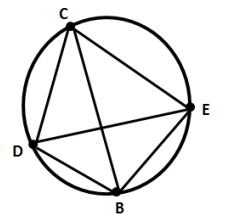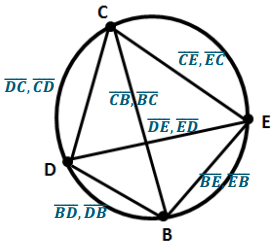Engage NY Eureka Math Precalculus Module 5 Lesson 3 Answer Key
Eureka Math Precalculus Module 5 Lesson 3 Example Answer Key
Example 1.
Seven speed skaters are competing in an Olympic race. The first – place skater earns the gold medal, the second – place skater earns the silver medal, and the third – place skater earns the bronze medal. In how many different ways could the gold, silver, and bronze medals be awarded? The letters A, B, C, D, E, F, and G will be used to represent these seven skaters.
How can we determine the number of different possible outcomes? How many are there?
Answer:
We can use the permutations formula from the previous lesson. Because each outcome is a way of forming an ordered arrangement of 3 things from a set of 7, the total number of possible outcomes is
7P3 = \(\frac{7 !}{(7 – 3) !}\) = \(\frac{7 !}{4 !}\) = 210.
Now consider a slightly different situation. Seven speed skaters are competing in an Olympic race. The top three skaters move on to the next round of races. How many different “top three” groups can be selected?
How is this situation different from the first situation? Would you expect more or fewer possibilities in this situation? Why?
Answer:
The outcomes in the first situation are medals based on order—first place gets gold, second place gets silver, and third place gets bronze. The outcomes in this situation are not based on order. The top three finishers move on; the others do not. I would expect more possibilities in the first situation because each skater can be first, second, or third and still advance (i.e., there are three different possible finishing positions each skater can attain to earn advancement). In the first situation, there is only one position to earn gold, one for silver, and one for bronze.
Would you consider the outcome where skaters B, C, and A advance to the final to be a different outcome from A, B, and C advancing?
Answer:
No. This is the same outcome—the same three skaters are advancing to the final competition.
A permutation is an ordered arrangement (a sequence) of k items from a set of n distinct items.
In contrast, a combination is an unordered collection (a set) of k items from a set of n distinct items.
When we wanted to know how many ways there are for seven skaters to finish first, second, and third, order was important. This is an example of a permutation of 3 selected from a set of 7. If we want to know how many possibilities there are for which three skaters will advance to the finals, order is not important. This is an example of a combination of 3 selected from a set of 7.
Example 2.
Let’s look closely at the four examples we have studied so far.

What do you notice about the way these are grouped?
Answer:
Sample responses: The examples on the left are permutations, and the examples on the right are combinations. In the left examples, the order of the outcomes matters, while in those on the right, the order does not matter.
The number of combinations of k items selected from a set of n distinct items is
nCk = \(\frac{{ }_{n} P_{k}}{\boldsymbol{k} !}\)or nCk = \(\frac{n !}{k !(n – k) !}\)
Answer:
The number of permutations of three skaters from the seven is found in Example 1 to be
7P3 = \(\frac{7 !}{(7 – 3) !}\) = \(\frac{7 !}{4 !}\) = 210.
This means that there are 210 different ordered arrangements of three skaters from a set of seven skaters.
There are fewer combinations because, when order is not important, we do not want to count different orders of the same three skaters as different outcomes.
3∙2∙1 = 3! = 6
Consider the set of skaters A, B, and C. There are 6 different ordered arrangements of these three skaters, each of which is counted with the permutations formula. So, if we want combinations of 3 from a set of 7, you would need to divide the number of permutations by 3!. Then,

Eureka Math Precalculus Module 5 Lesson 3 Exercise Answer Key
Exercises 1–4
Exercise 1.
Given four points on a circle, how many different line segments connecting these points do you think could be drawn? Explain your answer.
Answer:
Answers will vary. Expect answers to range from 4 to 42.
Exercise 2.
Draw a circle, and place four points on it. Label the points as shown. Draw segments (chords) to connect all the pairs of points. How many segments did you draw? List each of the segments that you drew. How does the number of segments compare to your answer in Exercise 1?

Answer:

6 segments: \(\overline{D C}\), \(\overline{D E}\), \(\overline{D B}\), \(\overline{C B}\), \(\overline{C E}\),and \(\overline{B E}\)
You can think of each segment as being identified by a subset of two of the four points on the circle. Chord ED is the same as chord DE. The order of the segment labels is not important. When you count the number of segments (chords), you are counting combinations of two points chosen from a set of four points.
Exercise 3.
Find the number of permutations of two points from a set of four points. How does this answer compare to the number of segments you were able to draw?
Answer:

The diagram is the same, but this answer is double the number of combinations. In a permutation, \(\overline{D C}\) is counted as different from \(\overline{C D}\). In this case, there are six combinations, and each segment can be represented two ways. 6 × 2 or 12 permutations
Exercise 4.
a. If you add a fifth point to the circle, how many segments (chords) can you draw?
Answer:
10 segments
b. If you add a sixth point, how many segments (chords) can you draw?
Answer:
15 segments
Exercises 5–11
Exercise 5.
Find the value of each of the following:
a. 9C2
Answer:
36
b. 7C7
Answer:
1
c. 8C0
Answer:
1
d. 15C1
Answer:
15
Exercise 6.
Find the number of segments (chords) that can be drawn for each of the following:
a. 5 points on a circle
Answer:
5C2 = 10
b. 6 points on a circle
Answer:
6C2 = 15
c. 20 points on a circle
ans”
20C2 = 190
d. n points on a circle
Answer:
nC2 = \(\frac{{ }_{n} P_{2}}{2 !}\) = \(\frac{n !}{2 !(n – 2) !}\)
Exercise 7.
For each of the following questions, indicate whether the question posed involves permutations or combinations. Then, provide an answer to the question with an explanation for your choice.
a. A student club has 20 members. How many ways are there for the club to choose a president and a vice president?
Answer:
Permutations, 380. The role of president is different from that of vice president. The order of outcomes matters.
b. A football team of 50 players will choose two co – captains. How many different ways are there to choose the two co – captains?
Answer:
Combinations, 1,225. Regardless of order, two players will attain the same outcome of co – captain.
c. There are seven people who meet for the first time at a meeting. They shake hands with each other and introduce themselves. How many handshakes have been exchanged?
Answer:
Combinations, 21. People only shake hands with those they have not greeted yet. Each greeting is unique. Person 1 shaking hands with person 2 is the same event as person 2 shaking hands with person 1.
d. At a particular restaurant, you must choose two different side dishes to accompany your meal. If there are eight side dishes to choose from, how many different possibilities are there?
Answer:
Combinations, 28. The order of dishes chosen does not matter. Choosing veggies and mac and cheese is the same as choosing mac and cheese and veggies.
e. How many different four – letter sequences can be made using the letters A, B, C, D, E, and F if letters may not be repeated?
Answer:
Permutations, 360. Each four – letter sequence is unique. ABCD is different from BACD even though they contain identical letters.
Exercise 8.
How many ways can a committee of 5 students be chosen from a student council of 30 students? Is the order in which the members of the committee are chosen important?
Answer:
No. 30C5 = 142 506
Exercise 9.
Brett has ten distinct T – shirts. He is planning on going on a short weekend trip to visit his brother in college. He has enough room in his bag to pack four T – shirts. How many different ways can he choose four T – shirts for his trip?
Answer:
10C4 = 210
Exercise 10.
How many three – topping pizzas can be ordered from the list of toppings below? Did you calculate the number of permutations or the number of combinations to get your answer? Why did you make this choice?
Pizza Toppings
sausage
pepperoni
meatball
onions
olives
spinach
pineapple
ham
green peppers
mushrooms
bacon
hot peppers
Answer:
12C3 = 220; I used combinations because the order of toppings chosen does not matter. My pizza is the same if I order pepperoni, olives, and mushrooms or olives, pepperoni, and mushrooms.
I calculated the number of combinations—we are choosing 3 items from the 12 distinct toppings, and the order that the 3 toppings are chosen is not important.
Exercise 11.
Write a few sentences explaining how you can distinguish a question about permutations from a question about combinations.
Answer:
Answers will vary but should address whether order is important or not.
Eureka Math Precalculus Module 5 Lesson 3 Problem Set Answer Key
Question 1.
Find the value of each of the following:
a.
9C8
Answer:
9
b. 9C1
Answer:
9
c. 9C9
Answer:
1
Question 2.
Explain why 6C4 is the same value as 6C2.
Answer:
6C4 = \(\frac{6 !}{4 ! \cdot 2 !}\)
6C2 = \(\frac{6 !}{2 ! \cdot 4 !}\)
The denominators are the same. This is because the number of ways to choose four from a set of six is the same as the number of ways to select which two to exclude.
Question 3.
Pat has 12 books he plans to read during the school year. He decides to take 4 of these books with him while on winter break vacation. He decides to take Harry Potter and the Sorcerer’s Stone as one of the books. In how many ways can he select the remaining 3 books?
Answer:
11C3 = 165
Question 4.
In a basketball conference of 10 schools, how many conference basketball games are played during the season if the teams all play each other exactly once?
Answer:
10C2 = 45
Question 5.
Which scenario or scenarios below are represented by 9C3?
A. The number of ways 3 of 9 people can sit in a row of 3 chairs
B. The number of ways to pick 3 students out of 9 students to attend an art workshop
C. The number of ways to pick 3 different entrees from a buffet line of 9 different entrees
Answer:
B and C
Question 6.
Explain why 10C3 would not be used to solve the following problem:
There are 10 runners in a race. How many different possibilities are there for the runners to finish first, second, and third?
Answer:
This is an example of a permutation. The order of how the runners finish is important.
Question 7.
In a lottery, players must match five numbers plus a bonus number. Five white balls are chosen from 59 white balls numbered from 1 to 59, and one red ball (the bonus number) is chosen from 35 red balls numbered 1 to 35. How many different results are possible?
Answer:
White ball: 59C5 = 5 006 386
Red ball: 35C1 = 35
Number of possible results: 5 006 386∙35 = 175 223 510
Question 8.
In many courts, 12 jurors are chosen from a pool of 30 perspective jurors.
a. In how many ways can 12 jurors be chosen from the pool of 30 perspective jurors?
Answer:
30C12 = 86 493 225
b. Once the 12 jurors are selected, 2 alternates are selected. The order of the alternates is specified. If a selected juror cannot complete the trial, the first alternate is called on to fill that jury spot. In how many ways can the 2 alternates be chosen after the 12 jury members have been chosen?
Answer:
18P2 = 306
Question 9.
A band director wants to form a committee of 4 parents from a list of 45 band parents.
a. How many different groups of 4 parents can the band director select?
Answer:
45C4 = 148 995
b. How many different ways can the band director select 4 parents to serve in the band parents’ association as president, vice president, treasurer, and secretary?
Answer:
45P4 = 3 575 880
c. Explain the difference between parts (a) and (b) in terms of how you decided to solve each part.
Answer:
Part (a) is an example of finding the number of combinations—how many ways can 4 parents be chosen from 45 distinct parents. The order is not important.
Part (b) is an example of finding the number of permutations. The order of how the parents are selected is important.
Question 10.
A cube has faces numbered 1 to 6. If you roll this cube 4 times, how many different outcomes are possible?
Answer:
Using the fundamental counting principle: 64 = 1296
Question 11.
Write a problem involving students that has an answer of 6C3.
Answer:
Answers will vary. One example follows:
There are six seniors on the principal’s advisory committee on school improvement. The principal would like to select three of the students to attend a workshop on school improvement. How many ways can the principal select three students out of the six students on the advisory committee?
Question 12.
Suppose that a combination lock is opened by entering a three – digit code. Each digit can be any integer between 0 and 9, but digits may not be repeated in the code. How many different codes are possible? Is this question answered by considering permutations or combinations? Explain.
Answer:
There are 720 possible codes. This question is answered by considering permutations because in a code, the order of the digits is important.
Question 13.
Six musicians will play in a recital. Three will perform before intermission, and three will perform after intermission. How many different ways are there to choose which three musicians will play before intermission? Is this question answered by considering permutations or combinations? Explain.
Answer:
There are 20 possible ways to choose the musicians. This question is answered by considering combinations because order is not important if we just care about which group of three is before the intermission.
Question 14.
In a game show, contestants must guess the price of a product. A contestant is given nine cards with the numbers 1 to 9 written on them (each card has a different number). The contestant must then choose three cards and arrange them to produce a price in dollars. How many different prices can be formed using these cards? Is this question answered by considering permutations or combinations? Explain.
Answer:
There are 504 possible prices. The question is answered by considering permutations because the order of the digits is important. $123 is different from $312.
Question 15.
a. Using the formula for combinations, show that the number of ways of selecting 2 items from a group of 3 items is the same as the number of ways to select 1 item from a group of 3.
Answer:
3C2 = \(\frac{3 !}{2 ! \cdot 1 !}\)
3C1 = \(\frac{3 !}{1 ! \cdot 2 !}\)
b. Show that nCk and nCn – k are equal. Explain why this makes sense.
Answer:
nCk = \(\frac{n !}{k ! \cdot(n – k) !}\)
nCn – k = \(\frac{n !}{(n – k) ! \cdot k !}\)
The denominators are the same. This is because the number of ways to choose k from a set of n is the same as the number of ways to select which (n – k) to exclude.
Eureka Math Precalculus Module 5 Lesson 3 Exit Ticket Answer Key
Question 1.
Timika is a counselor at a summer camp for young children. She wants to take 20 campers on a hike and wants to choose a pair of students to lead the way. In how many ways can Timika choose this pair of children?
Answer:
20C2 = 190
Question 2.
Sean has 56 songs on his MP3 player. He wants to randomly select 6 of the songs to use in a school project. How many different groups of 6 songs could Sean select? Did you calculate the number of permutations or the number of combinations to get your answer? Why did you make this choice?
Answer:
56C6 = 32 468 436
I calculated the number of combinations—choosing 6 songs from 56 distinct songs, and order is not important.
Question 3.
A fast food restaurant has the following options for toppings on their hamburgers: mustard, ketchup, mayo, onions, pickles, lettuce, and tomato. In how many ways could a customer choose four different toppings from these options?
Answer:
7C4 = 35
Question 4.
Seven colored balls (red, blue, yellow, black, brown, white, and orange) are in a bag. A sample of three balls is selected without replacement. How many different samples are possible?
Answer:
7C3 = 35